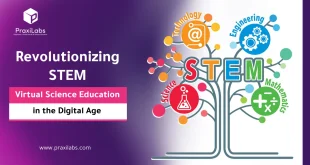Last Updated on October 26, 2025 by Muhamed Elmesery Polymerase chain reaction is a fundamental procedure used for DNA amplification in several fields such as molecular biology research, forensic science, diagnostics, and more! In this blog post we will learn more about the online PCR simulation , its benefits, types of online PCR simulation at PraxiLabs, and the advantages of …
Read More »virtual learning articles
Virtual Science Education in Revolutionizing STEM
Last Updated on May 3, 2025 by Muhamed Elmesery Virtual science education refers to a virtual environment that enables students to study a digital-based curriculum taught remotely by instructors who lecture online via video or audio and also with the help of technologies such as virtual labs, augmented reality, e-learning platforms, and more. Students can access their curriculum anytime, anywhere …
Read More »How Simulation Analysis in Biology and Virtual Labs are Shaping Science Education
Last Updated on October 26, 2025 by Muhamed Elmesery Simulation analysis in biology involves the use of computer simulations of biological systems to analyze and visualize complex cellular processes. The biological systems include the networks of metabolites and enzymes which comprise metabolism, signal transduction pathways, gene regulatory networks, and more. In this blog post, we will explore simulation analysis in …
Read More »How Online Chemistry Tutors and Virtual Labs Transform Learning
Last Updated on October 26, 2025 by Muhamed Elmesery An online chemistry tutor has become very common and important in recent years. He can be advantageous for both students and parents. Online chemistry tutor offers a flexible and convenient learning experience that improves students’ understanding of scientific concepts. In this blog post we will understand more about the role of …
Read More »11 Chemistry Experiments for College Every Student Should Try!
Last Updated on September 17, 2025 by Muhamed Elmesery Chemistry experiments for college are more than just a requirement for your degree—they’re a thrilling gateway to understanding the intricate workings of the universe, and exploring the principles behind everyday substances. Chemistry Lab Experiments not only deepen your knowledge but also ignite your passion for science. In this blog post we …
Read More » PraxiLabs A virtual world of science
PraxiLabs A virtual world of science










